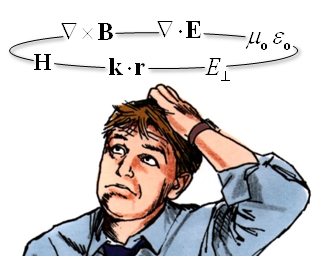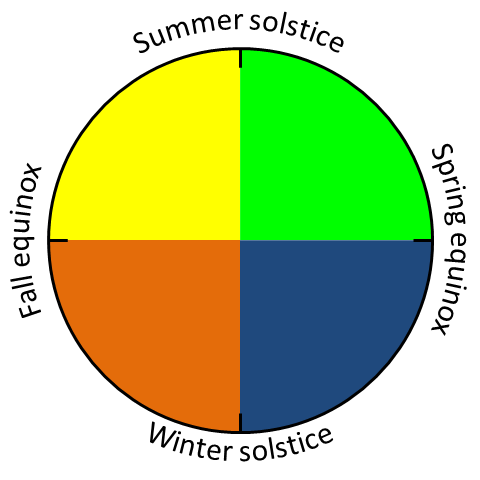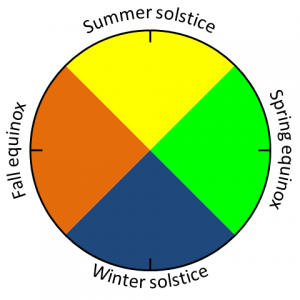In my role in the Carl Wieman Science Education Initiative at the University of British Columbia, I am often “embedded” in an instructor’s course, providing resources, assistance and coaching throughout the term. This term, I’m working with an instructor in a final-year, undergraduate electromagnetism (E&M) course.
The instructor has already done the hard part: he recognized that students were not learning from his traditional lectures and committed to transforming his classes from instructor-centered to student-centered. Earlier, I wrote about how we introduced pre-reading assignment and in-class reading quizzes.
This course is heavy on the math. Not new math techniques but instead, math the students have learned in the previous 3 or 4 years applied to new situations. His vision, which he shared with the students on the first day, was to introduce some key concepts and then let them “do the heavy lifting.” And by heavy lifting, he means the algebra.
The vector for this heavy lifting is daily, in-class worksheets. The students work collaboratively on a sequence of questions, typically for 15-20 minutes, bookended by mini-lectures that summarize the results and introduce the next concept.
We’re making great strides, really. After some prompting by me, the instructor is getting quite good at “conducting” the class. There are no longer moments when the students look at each other thinking, “Uh, what are supposed to be doing right now? This worksheet?” It’s fine to be puzzled by the physics, that’s kind of the point, but we don’t want students wasting any of their precious cognitive load on divining what they should be doing.
With this choreography running smoothy and the students participating, we’re now able to look carefully at the content of the worksheets. Yes, I know, that’s something you should be planning from Day 1 but let’s face it, if the students don’t know when or how to do a worksheet, the best content in the World won’t help them learn. Last week’s worksheet showed we’ve got some work to do.

(Confused guy from the interwebz. I added the E&M canaries.)
The instructor handed out the worksheet. Students huddled in pairs for a minute or two and them slumped back into their seats. You know those cartoons where someone gets smacked on the head and you see a ring of stars or canaries flying over them? You could almost see them, except the canaries were the library of equations the students are carrying in their heads. They’d grasp at a formula floating by, jam it onto the page, massage it for a minute or two, praying something would happen if they pushed the symbols in the right directions. Is it working? What if I write it like….solve for….Damn. Grab another formula out of the air and try again…
After 10 minutes, some students had answered the problem. Many others were still grasping at canaries. The instructor presented his solution on the document camera so he could “summarize the results and introduce the next concept.” The very first symbols at the top-left of his solution were exactly the correct relationship needed to solve this problem, magically plucked from his vast experience. With that relationship, and a clear picture of where the solution lay, he got there in a few lines. The problem was trivial. No surprise, the students didn’t react with “Oh, so that’s why physics concept A is related to physics concept B! I always wondered about that!” Instead, they responded with, “Oh, so that’s how you do it,” and snapped some pix of the screen with their phones.
Scaffolding and Spoon-feeding
We want the worksheets to push the students a bit. A sequence of questions and problems in their grasp or just beyond, that guide them to the important result or concept of the day. Here’s what doesn’t work: A piece of paper with a nasty problem at the top and a big, blank space beneath. I’ve seen it, often enough. Students scan the question. The best students dig in. The good and not-so-good students scratch their heads. And then bang their heads until they’re seeing canaries.
There are (at least) 2 ways to solve the problem of students not knowing how to tackle the problem. One is to scaffold the problem, presenting a sequence of steps which activate, one by one, the concepts and skills needed to solve the nasty problem. The Lecture Tutorials used in many gen-ed “Astro 101” astronomy classes, and the Washington Tutorials upon which they’re modeled, do a masterful job of this scaffolding.
Another way, which looks the same on the surface, is to break the nasty problem into a sequence of steps. “First, find the relationship between A and B. Then, calculate B for the given value of A. Next, substitute A and B into C and solve for C in terms of A…” That’s a sequence of smaller problems that will lead to a solution of the nasty problem. But it’s not scaffolding: it’s spoon-feeding and it teaches none of the problem-solving skills we want the students to practice. I’ve heard from number of upper-level instructors declare they don’t want to baby the students. “By this stage in their undergraduate studies,” the instructors say, “physics students needs to know how to tackle a problem from scratch.”
This is the dilemma I’m facing. How do we scaffold without spoon-feeding? How do we get them solving nasty problems like a physicist without laying a nice, thick trail of bread crumbs?
Fortunately, I have smart colleagues. Colleagues who immediately understood my problem and knew a solution: Don’t scaffold the nasty problem, scaffold the problem-solving strategy. For a start, they say, get the instructor to model how an expert physicist might solve a problem. Instead of slapping down an elegant solution on the document cam, suppose the instructor answers like this:
- Determine what the problem is asking. Alright, let’s see. What is this problem about? There’s A and B and their relationship to C. We’re asked to determine D in a particular situation.
- Identify relevant physics. A, B, C and D? That sounds like a problem about concept X.
- Build a physics model. Identify relevant mathematical relationships. Recognize assumptions, specific cases. Select the mathematical formula that will begin to solve the problem.
- Execute the math. Carry out the algebra and other manipulations and calculations.
(This is where the instructor has been starting his presentation of the solutions.) - Sense-making. Sure, we ended up with an expression or a number. Does it make sense? How does it compare the known cases when A=0 and B goes to infinity? How does the order of magnitude of the answer compare to other scenarios? In other words, a few quick tests which will tell us our solution is incorrect.
Wouldn’t it be great if every student followed a sequence of expert-like steps to solve every problem? Let’s teach them the strategy, then, by posing each nasty problem as a sequence of 5 steps. “Yeah,” my colleagues say, “that didn’t work. The students jumped to step 4, push some symbols around and when a miracle occurred, they went back and filled in steps 1, 2, 3 and 5.” Students didn’t buy into the 5-step problem-solving scheme when it was forced upon them.
So instead, for now, I’m going to ask the instructor to model this approach, or his own expert problem-solving strategy, when he presents his solutions to the worksheet problems. When the students see him stop and think and ponder, they should realize this is an important part of problem-solving. The first thing you do isn’t scribbling down some symbols. It’s sitting back and thinking. Maybe even debating with your peers. Perhaps you have some insight you can teach to your friend. Peer instruct, that is.












